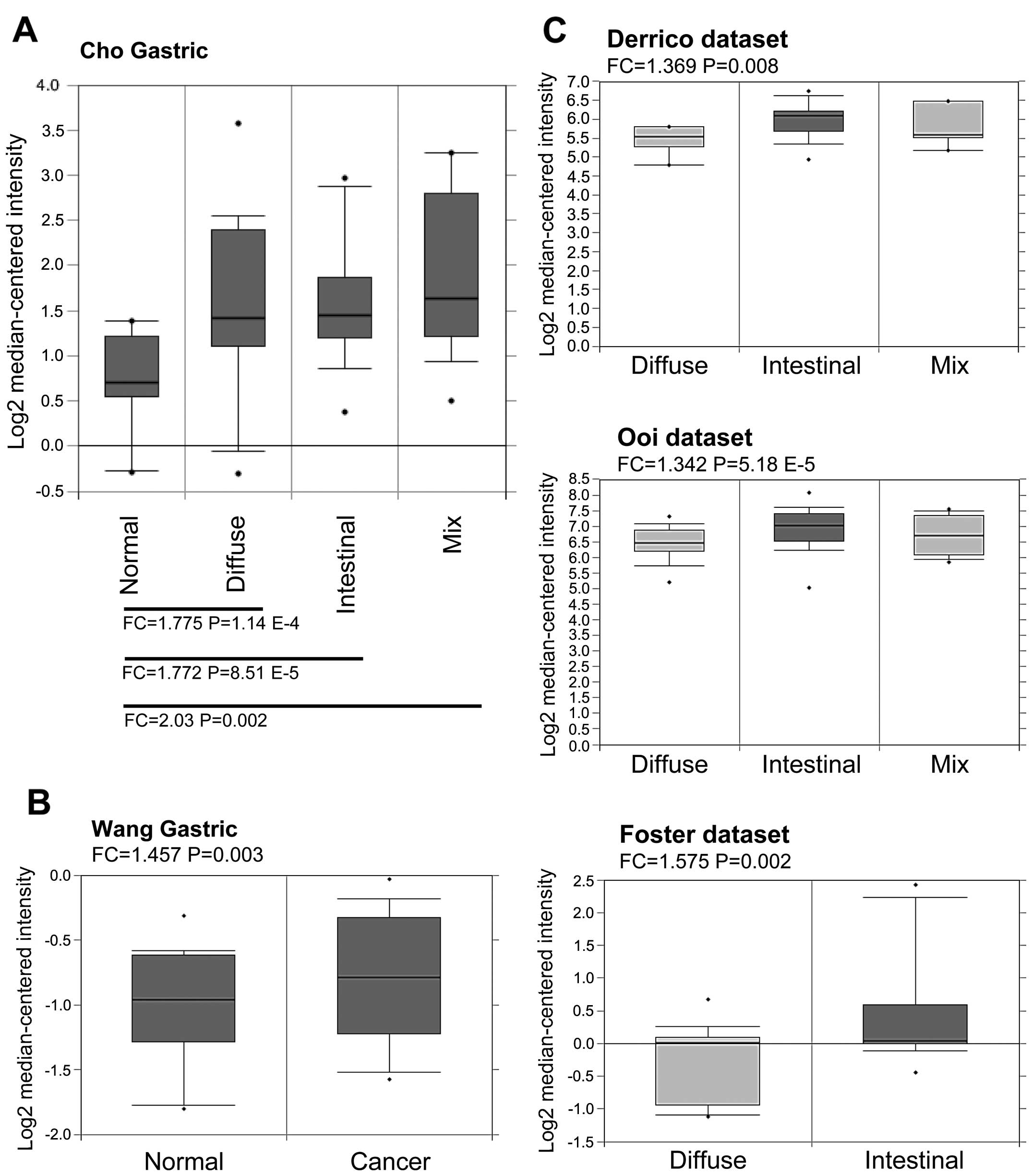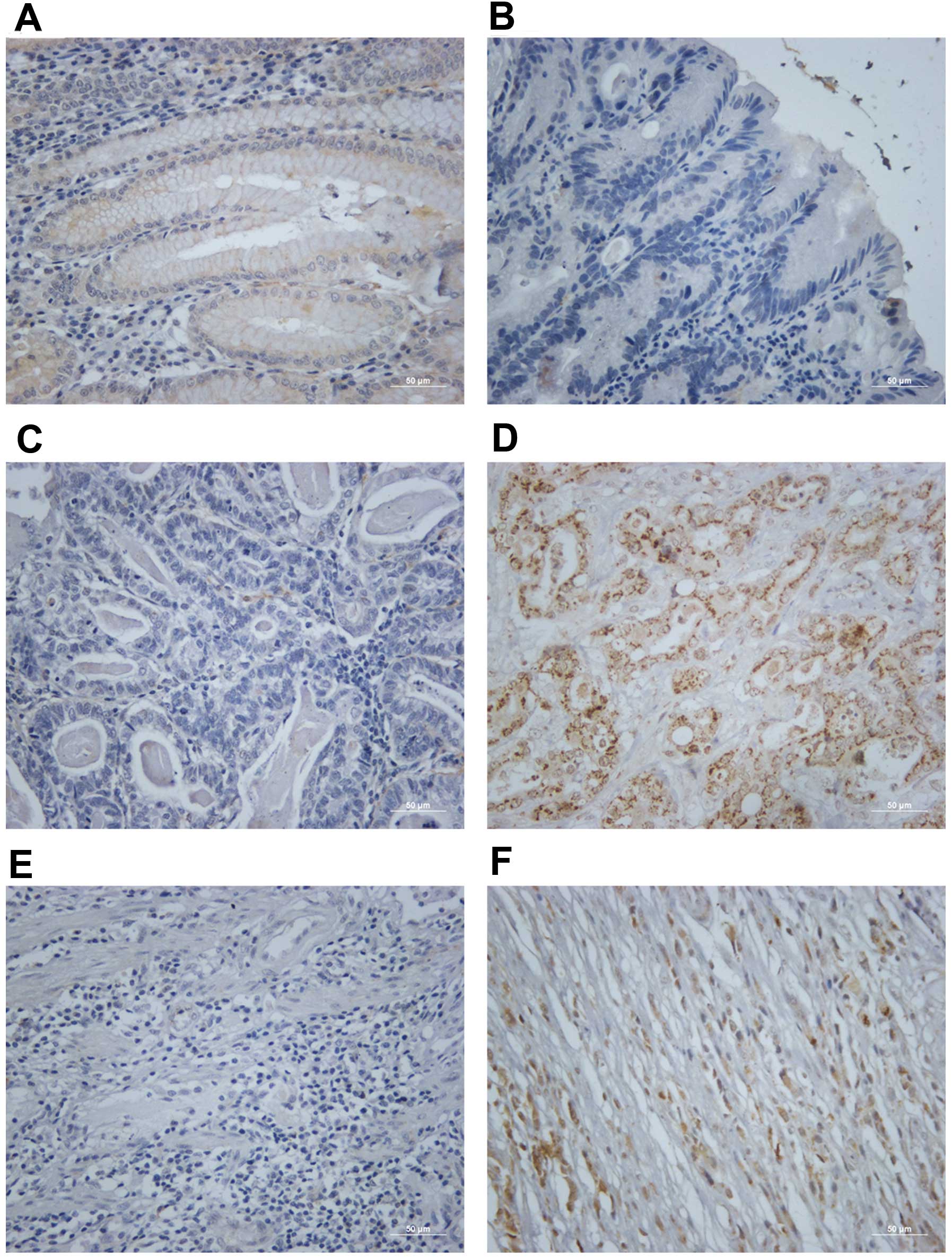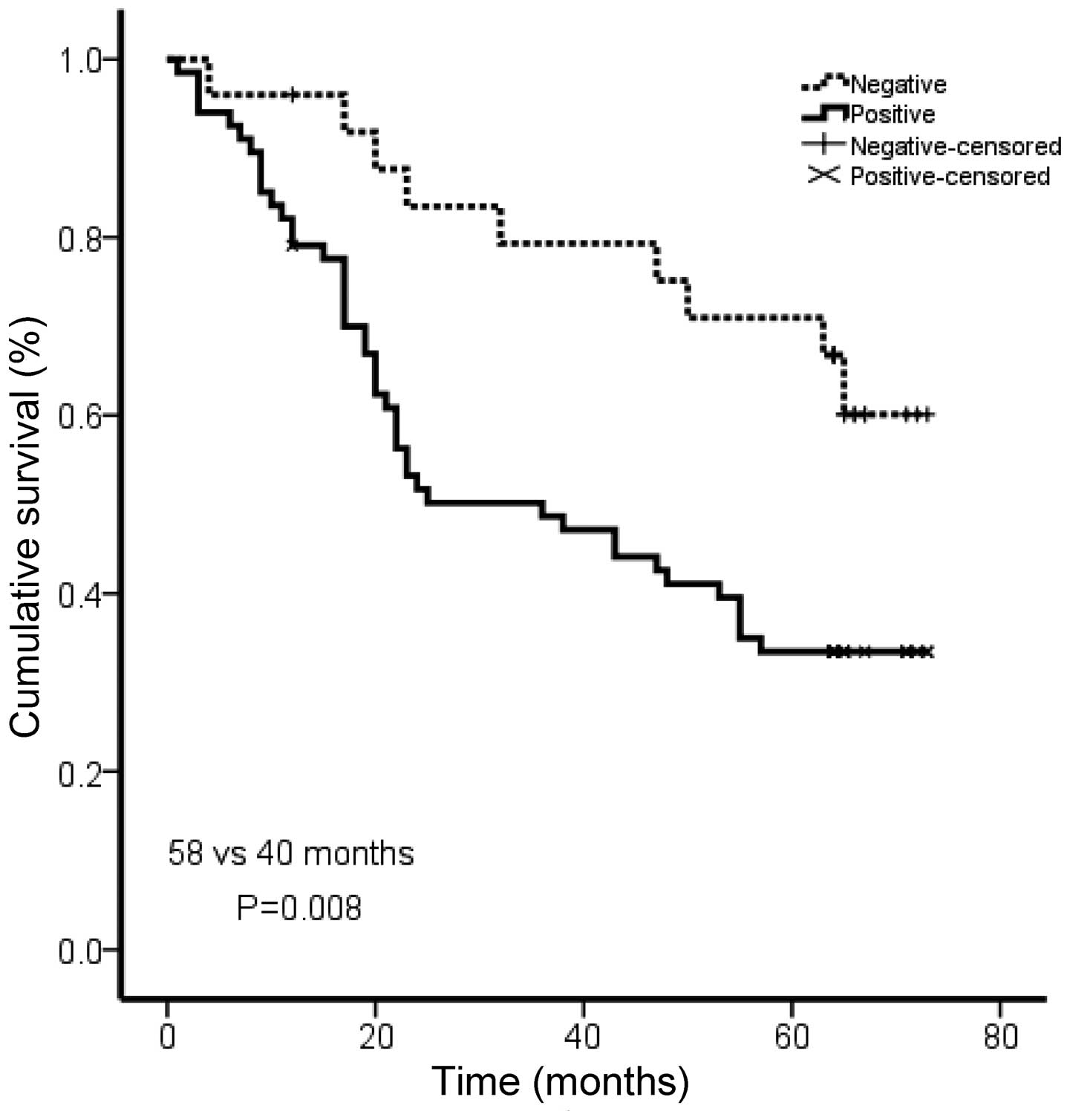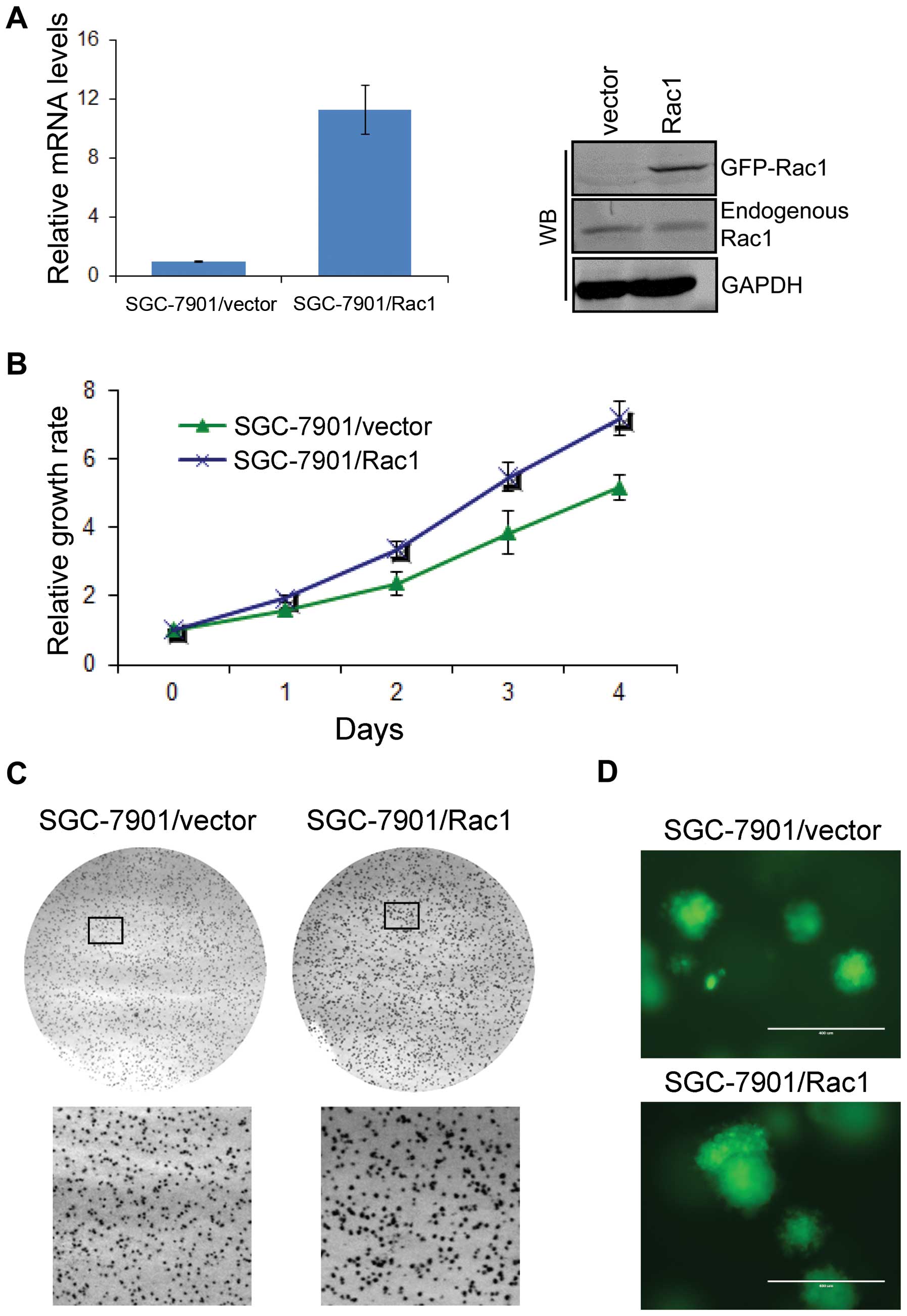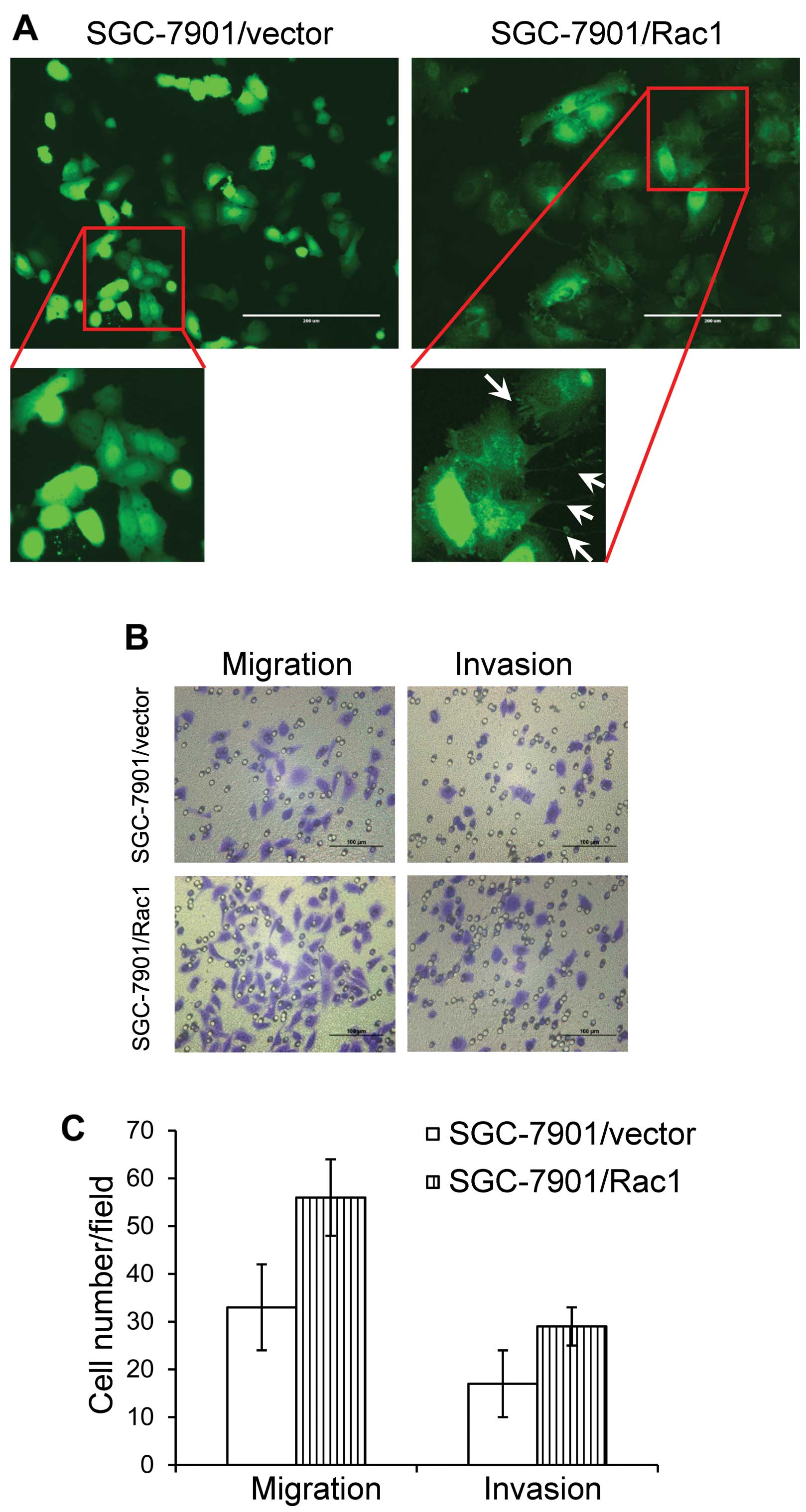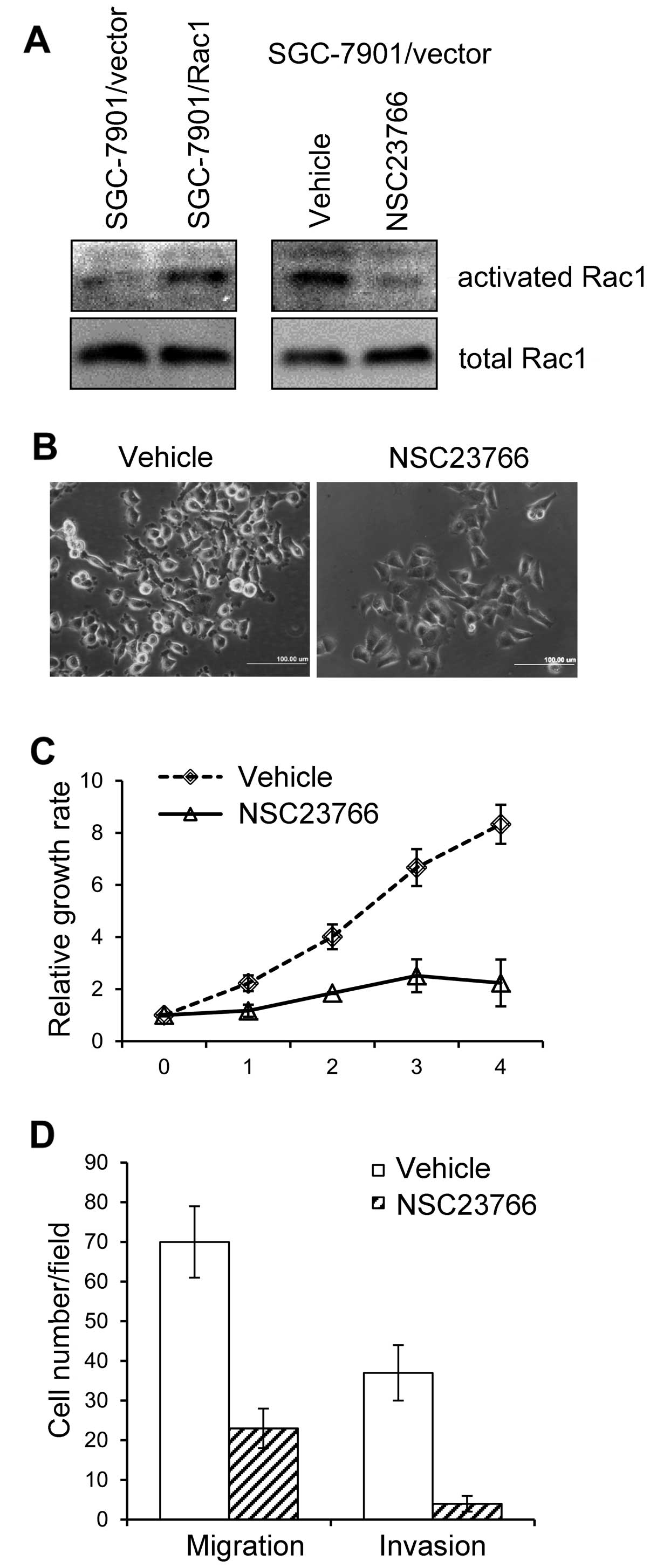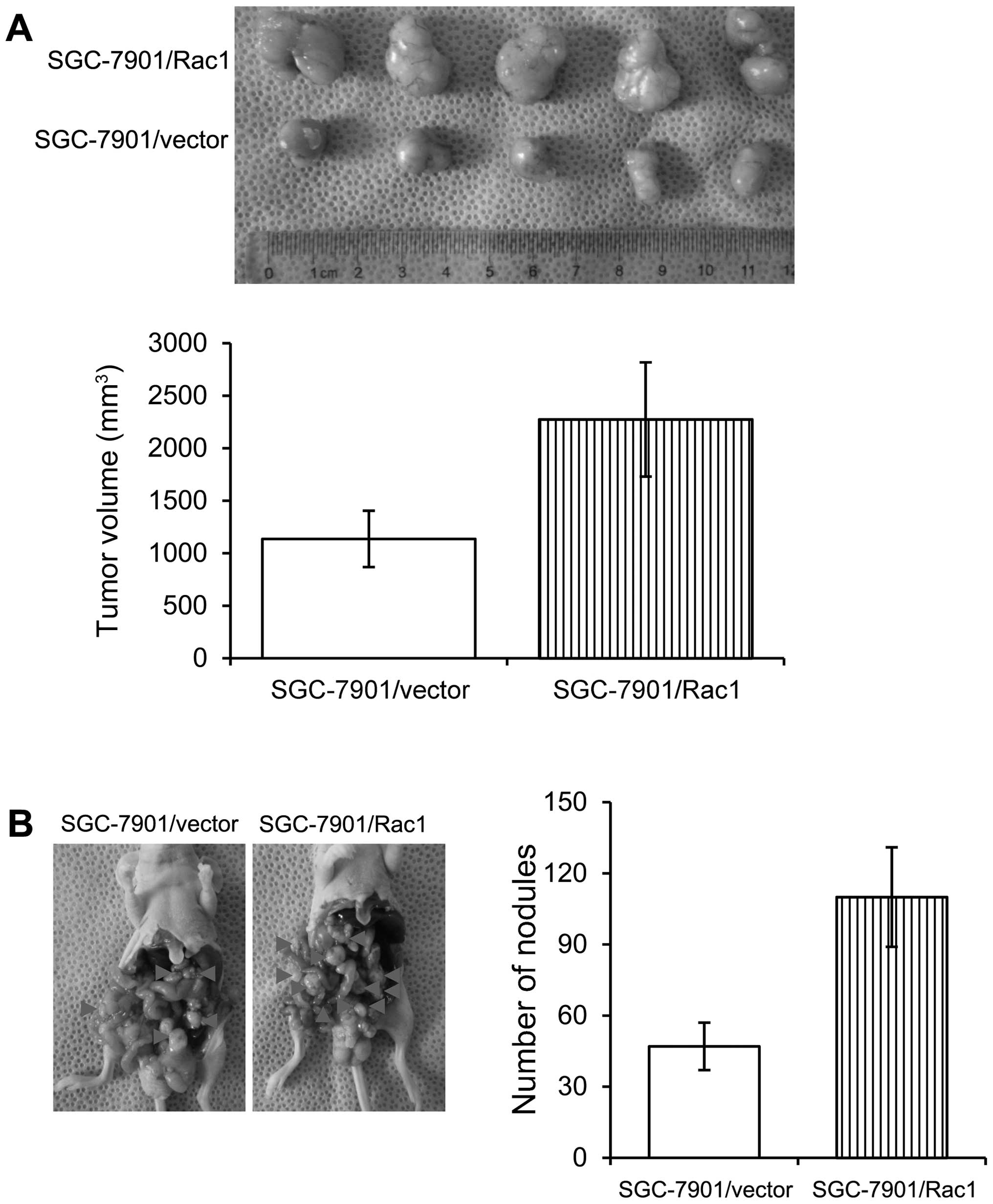Rac1 is correlated with aggressiveness and a potential therapeutic target for gastric cancer
- Authors:
- Published online on: January 13, 2015 https://doi.org/10.3892/ijo.2015.2836
- Pages: 1343-1353
Abstract
Introduction
Gastric cancer is the fourth most common cancer worldwide and is the second most common cause of cancer-related deaths. Due to lack of specific symptoms, gastric cancer patients are often diagnosed at advanced stage. Advanced gastric cancer has a poor prognosis (1) due to its high rate of metastasis. The identification of predictive markers for cancer progression and prognosis would facilitate evaluating the clinical outcome and potential treatment stratification for patients with gastric cancer. More importantly, identification of such markers with biological functions that are critical in gastric tumorigenesis and progression will also provide targets for cancer specific treatment.
Rho GTPases are sensitive molecular switches existing either in an inactive, GDP-bound form or an active GTP-bound form. They are endowed with GTP hydrolytic activity, mainly involved in cytoskeleton rearrangements and cell motility, but also involved in cell proliferation, transformation and differentiation (2). The exchange of GDP to GTP and thus the activation of Rho GTPases are catalyzed by guanine nucleotide exchange factors (GEFs), which act as downstream factors for many extracellular growth factors. Thus, Rho GTPases are key integrating molecules from different extracellular signals. When activated, Rho GTPases can interact and activate a large panel of effectors that are responsible for regulating critical cellular functions. Members of the Rho small GTPases family, prototype RhoA, Rac1 and Cdc42, are involved in the regulation of a variety of cellular processes, such as organization of the microfilament network, cell-cell contact, and malignant transformation and also perform essential and specialized functions during organization of the actin cytoskeleton.
Ras-related C3 botulinum toxin substrate 1 (Rac1) is a member of the small molecule G-protein Rho family (Ras homologue) and is an important class of intracellular signaling molecules. RAC1 activity, as a modulator of the cytoskeleton, is critical for a number of normal cellular activities including phagocytosis, mesenchymal-like migration, axonal growth, adhesion and differentiation of multiple cell types. Rac1 also plays key roles in transmitting upstream signaling, such as receptors for extracellular growth factors (3) and receptor tyro-sine kinases (RTKs) (4), into downstream cascades and, thus, modulates cellular functions. Upon activation, Rac1 interacts with various specific effectors to coordinate the activation of a multitude of signaling cascades that influence diverse physiological outcomes. For example, Pak1 binds to Rac1 in a GTP-dependent manner, after which activated Pak1 regulates cellular functions such as cytoskeletal dynamics, cell adhesion and transcription (5). Rac1 signals can also activate MAPK family member including p38, p42/44 and c-Jun N-terminal kinase (JNK) (6–9). Rac1 was found being able to elevate cytosolic and nuclear levels of β-catenin, thus, activated Wnt signaling cascades (10).
Although Rac1 as a cytoskeleton organizer has been documented well, more and more recent findings provoked broad functions of Rac1 in human cancers. Rac1 regulates a diverse spectrum of cellular functions including tumorigenesis (11), angiogenesis (12,13) and metastasis (11,14,15). Overexpression of Rac1 occurs in several different types of tumors including breast (16,17), colon (18), bladder (19), and gastric cancer (20,21). Rac1 overexpression was observed in metastatic gastric (21), breast (15), prostate (22), bladder upper urinary tract cancer (19). Rac1 promoted prostate cancer progression and recurrence upon activation by VAV3, a GEF for Rac1 activation (14). Rac1 is also involved in sustained cell growth (23) and therapy resistance (24) through crosstalk with other signaling pathways. Rac1 regulates vasculogenesis and angiogenesis, two distinct but related steps in vasculature. Thus, Rac1 has been shown closely related with tumor angiogenesis and microvascular density (13). As Rac1 is intimately involved in broad range of cellular functions in human cancers and emerging as a potential target for anticancer therapies, we explored the clinical correlation of Rac1 in gastric cancer specimens and its biological impacts on gastric cancer malignancy. Our studies suggest that Rac1 is correlated with an aggressive phenotype in gastric cancer and may serve as a target against gastric cancer.
Materials and methods
Patients and specimens
Gastric cancer tissues, confirmed by pathological diagnosis, were obtained from 92 patients who under went radical resection for gastric cancer between 2006 and 2008 at the Department of Surgery, Ruijin Hospital, Shanghai, China. The corresponding non-tumor gastric tissue was obtained at least 6 cm from the tumor. All tissue samples were formalin-fixed and paraffin-embedded. Clinicopathological and survival data of all patients were collected. TNM staging was classified based on the criteria of the American Joint Committee on Cancer (AJCC, 7th edition) for gastric cancer. The mean age of the patients at initial surgery was 63 years (range, 37–84 years); 62 men and 30 women were included in the present study. The mean duration of follow-up was 39 months (range, 1–73 months). The AJCC tumor stage distribution and vital status of the patients are shown in Table I. The study was approved by the Shanghai Jiao Tong University Medical School Institutional Review Board. Informed written consent to participate in the study was obtained from each of the patients before the entry into the study.
Immunohistochemistry staining
Immunohistochemistry (IHC) staining was performed using a highly sensitive streptavidin-biotin-peroxidase detection system with gastric cancer tissue microarrays. Rabbit anti-Rac1 at a dilution of 1:50 (Abcam, Cambridge, MA, USA) was used as previously reported (25). Mayer’s haematoxylin was used for counterstain. The slides were evaluated by a single board-certified pathologist (R.R.T.) who remained blinded to the clinical data using standard light microscopy.
Immunohistochemistry assessment
Expression status of Rac1 was determined by using a semi-quantitative scoring system based on the percentage of positive cells. The percentage of positive cells was divided into four grades (percentage scores): <5% (0), 5–25% (1), 25–50% (2), 50–75% (3) and >75% (4). All analyses were performed with the SPSS 17.0 software (SPSS Inc., Chicago, IL, USA). Correlation between Rac1 expression and clinical parameters was analyzed using the Pearson correlation coefficient analysis. Overall survival was calculated with the Kaplan-Meier method, and differences were compared by the log-rank test. P-value <0.05 was considered as statistically significant.
Plasmids and transfection
The GFP-fused wild-type Rac1 (Rac1) and GFP-empty vector (vector) (26) were purchased from Addgene (Cambridge, MA, USA). For plasmid transfection, cells were seeded into 6-well plate and allowed to grow 24 h prior to transfection. Cells in each well were transfected with 4 μg plasmid using Lipofectamine 2000 (Invitrogen). Clones stably transfected with either Rac1 or GFP vectors were selected through G418 culture.
Gastric cancer cell lines and cell culture
Gastric cancer cell lines AGS, NCI-N87, MKN45, MKN28, SGC-7901, KATO III, BGC823, MGC803, SNU-1 and SNU-16 were preserved in our institute. The cells were grown in RPMI-1640 medium containing 10% fetal bovine serum (FBS), penicillin and streptomycin (Gibco-BRL, Gaithersburgh, MD, USA). Cell proliferation was assessed by the 3-(4,5-dimethylthiazol-2-yl)-2,5-diphenyltetrazolium (MTT) (Sigma, St. Louis, MO, USA) assay. Rac1 inhibitor NSC23766 was obtained from Merck Biosciences (Darmstadt, Germany). Final concentration of NSC23766 in treating cells was 100 μM (27).
Soft agar and Matrigel 3D culture
Soft agar colony formation assay was performed by using 0.3% agar in complete medium with cells as the feeder layer and 0.6% agar in complete medium as the bottom layer. 3D Matrigel culture was performed using Matrigel matrix (BD Biosciences, San Jose, CA, USA).
Reverse transcription and quantitative real-time PCR (qRT-PCR)
Total RNA was isolated from cultured cells using the RNeasy mini kit (Qiagen) and cDNA was synthesized with oligo (dT) primers by using of a SuperScript First-strand cDNA Synthesis kit (Invitrogen) according to the manufacturer’s protocols. Gene expression was assessed by qRT-PCR using an Applied Biosystems 7500 Fast Sequence detection system (Life Technologies, Carlsbad, CA, USA). The PCR reaction mixture consisted of QuantiTect SYBR-Green PCR Master Mix (2× QuantiTect SYBR-Green kit, contains HotStart Taq® DNA polymerase, QuantiTect SYGB-Green PCR buffer, dNTP mix, SYGB I, Rox passive reference dye and 5 mM MgCl2) (Qiagen), 0.5 μmol/l of each primer and cDNA. The transcript of the housekeeping gene, glyceraldehyde-3-phosphate dehydrogenase (GAPDH) gene was used as endogenous control to normalize expression data. The comparative Ct (threshold cycle) method was used to calculate the relative changes in gene expression. The primers used to amplify Rac1 were: 5′-ATGTCCGTGCAAAGTGGTATC-3′ (forward) and 5′-CTCGGATCGCTTCGTCAAACA-3′ (reverse). Primers to amplify GAPDH were 5′-AATGGGCAGCCGTTAGGAAA-3′ (forward) and 5′-GCCCAATACGACCAAATCAGAG-3′ (reverse).
Immunofluorescence imaging
Immunofluorescence images were visualized using Olympus BX50 microscope (Olympus Opticol Co., Tokyo, Japan), images were taken using Nikon Digital Sight DS-U2 (Nikon, Tokyo, Japan), and NIS elements F3.0 software was used (Nikon). Confocal images were taken by inverted Zeiss LSM 710 confocal microscope (40× oil lens) (Carl Zeiss, Oberkochen, Germany). Zen 2009 Light Edition (Carl Zeiss) was used for the measurement of images.
Cell migration and invasion assays
Cell migration was analyzed by a Transwell chamber assay. Cell invasion assays were performed using BD BioCoat™ Matrigel™ Invasion Chambers. FCS (10%) was used as the chemoattractant. Cells on the lower surface of the insert were fixed and stained followed by counting under a light microscope. Cells were visualized using Olympus BX50 microscope (Olympus Opticol Co.), images were taken using Nikon Digital Sight DS-U2 (Nikon), and NIS elements F3.0 software was used (Nikon).
Cell lysis and western blot analysis
Cells were incubated for 4.5 h after transfection, washed once with PBS, and incubated an additional 1.5 h in DMEM lacking serum. Cells were washed twice with cold PBS and lysed with 150–200 μl HEPES lysis buffer [50 mM HEPES (pH 7.0), 150 mM NaCl, 1% Triton X-100, 10% glycerol, 50 mM NaF and 1 mM Na3VO4] supplemented with protease inhibitors (5 μg/ml leupeptin, 5 μg/ml aprotinin, 1 μg/ml pepstatin and 100 μM PMSF). Lysates were cleared at maximum speed in a microcentrifuge at 4°C, and the protein concentration of each sample was determined using the Bio-Rad protein reagent. For western blots, proteins were resolved on 12% SDS-PAGE gels and transferred to PVDF membrane. Antibodies against Rac1 and GAPDH were purchased from Abcam.
Activity of Rac1 assay
The activation of Rac1 was measured using Rac1 Activation Assay Biochem kit (Cytoskeleton, Denver, CO, USA). Briefly, cell lysates were collected using lysis buffer from the kit. The activated forms of Rac1 were combined by PAK-PBD affinity beads. Beads were centrifuged and activate GTPases were pulled-down in the bead pallets. Bound GTPases were eluted by SDS buffer and analyzed by SDS-PAGE and western blotting. Rac1 levels were analyzed by the specific antibodies.
In vivo tumorigenesis and metastasis
Male BALB/c nu/nu nude mice (Institute of Zoology Chinese Academy of Sciences, Shanghai, China), were housed at a specific pathogen-free environment in the Animal Laboratory Unit, School of Medicine, Shanghai Jiao Tong University, China. Mice received humane care and the study protocols were approved by the Animal Care and Use Committee and conducted in accordance with the Guide for the Care and Use Laboratory Animals of Ruijin Hospital, Shanghai Jiaotong University School of Medicine. Cells (1×106) were subcutaneously injected into 4-week-old male BALB/c mice. Tumor length (L) and width (W) were measured and tumor volume was calculated by the equation: Volume = (W2 × L)/2 (28). Mice were sacrificed 28 days after injection under anesthesia. Ten mice were used in each group. To produce peritoneal spreading experimental metastasis, 2×106 cells were injected into 5-week-old male BALB/c nude mice intraperitoneally. After 6 weeks, the mice were sacrificed under anesthesia. Ten mice were used in each group. Macrometastatics were visualized and counted.
Statistical analysis
The statistical analyses were performed using SPSS 13.0 software (SPSS Inc., Chicago, IL, USA). Values represent mean ± standard deviation (SD) of samples measured in triplicate. Each experiment was repeated three times, unless otherwise indicated. The significance of differences between experimental groups was analyzed using the Student’s t-test and two-tailed distribution.
Results
Rac1 mRNA is overexpressed in human gastric cancer tissues
We first searched publicly available Oncomine database for the general information of Rac1 expression in gastric cancer tissues from previous publications. As we expected, Rac1 mRNA showed elevated levels compared with normal tissues. As shown in Fig. 1A and B, Rac1 mRNA levels were found to be higher in all the subtypes of gastric cancer compared with paired non-tumor tissues or normal gastric mucosal tissues in Cho et al (29) and Wang et al (30) datasets. Furthermore, by comparing Rac1 mRNA levels within different subtypes based on Lauren’s classification, all the available datasets showed Rac1 mRNA levels were higher in intestinal-type than diffuse- and mix-types in D’Errico et al (31), Ooi et al (32), and Foster et al (33) data-sets (Fig. 1C). These data suggest that Rac1 mRNA levels are elevated in gastric cancer tissues.
Rac1 protein is overexpressed in human gastric cancer tissues
We performed immunohistochemistry staining to examine the Rac1 protein expression in gastric cancer tissues. Gastric tumor and paired non-tumor tissues from 92 patients were stained. Rac1 positivity was observed in several crypt and isthmus epithelial cells (Fig. 2A) but not the surface epithelium (Fig. 2B) in normal gastric tissues. Positive Rac1 staining was 72.8% (67 of 92) in gastric cancer tissues, and 27.2% (25 of 92) of the samples showed negative staining. Rac1 positivity was cytoplasmic, and in the membrane of the cancer cells (Fig. 2D and F) compared with negative staining (Fig. 2C and E). A significant correlation was found between positive expression of Rac1 with gender (female, P<0.001), local invasion (T3/4, P<0.001), lymph node metastasis (P<0.001), distant metastasis (M1, P<0.001), late TNM stage (III/IV, P=0.024), Lauren’s classification (intestinal type, P<0.001) and differentiation status (well and moderate, P<0.001) (Table II). These data suggest that Rac1 is highly expressed in a subset of human gastric cancer which shows more malignant characteristics according to clinicopathological features.
Rac1 expression levels are correlated with shorter survival in gastric cancer patients
To investigate the prognostic significance of Rac1 in gastric cancer, we analyzed the correlation of Rac1 with patients’ survival using Kaplan Meier analysis. The patients in the Rac1-positive group showed shorter overall survival than those in Rac1-negative group (medium survival, 40.0 vs. 58.0 months, P=0.008; Fig. 3). Our data suggested an association between Rac1 expression and a short overall survival in gastric cancer patients.
Expression of Rac1 in gastric cancer cell lines
We then analyzed the Rac1 expression in human gastric cancer cell lines and immortalized normal gastric epithelial cell line GES-1. We first performed qRT-PCR and immunoblotting to analyze the Rac1 mRNA and protein levels in gastric cancer cell lines and GES-1. In consistent with database analysis, we showed that Rac1 mRNA (Fig. 4A) and protein (Fig. 4B) levels were highly expressed in all gastric cancer cell lines compared to GES-1. These data demonstrate that Rac1 is highly expressed in gastric cancer cell lines.
Overexpression of Rac1 in gastric cancer cells increases cell proliferation in monolayer and 3D culture
We next explored the role of Rac1 in gastric cancer cells. To do so, we generated Rac1 overexpression models using SGC-7901 (Fig. 5A) and BGC823 cell line (data not shown), which expressed moderate and low levels of Rac1, respectively. Analyzed by quantitative RT-PCR and western blotting, Rac1 mRNA (Fig. 5A, left panel) and protein (Fig. 5A, right panel) levels were increased in Rac1 stable transfectants compared with vector-control transfectants. To investigate the role of Rac1 in the growth of gastric cancer cells, we first performed a cell proliferation assay in monolayer culture. As shown in Fig. 5B, Rac1 over-expression significantly increased cell growth in monolayer culture. We then performed soft agar and Matrigel 3D culture. As expected, we found that Rac1 overexpression promoted the growth of SGC-7901 (Fig. 5C) and BGC823 (data not shown) gastric cancer cells in soft agar as suggested by larger colonies. Similarly, Rac1 overexpressing cells formed bigger spheres in Matrigel 3D culture (Fig. 5D). These data suggest that Rac1 overexpression increases cell proliferation in monolayer and 3D condition.
Overexpression of Rac1 in gastric cancer cells increases cell migration and invasion
We observed a morphological alteration in Rac1-overexpressing cells, with abundant cell protrusions and membrane ruffling (Fig. 6A, arrows). This phenomenon suggested a highly aggressive feature. As Rac1 expression was positively correlated with the aggressiveness in gastric cancer specimens, we next asked whether overexpression of Rac1 affected the ability of gastric cancer migration and invasion. Boyden chamber assays were used to investigate the in vitro ability of migration and invasion in Rac1-overexpression and vector-control cells. As expected, Rac1-overexpression induced more cells to migrate through the Boyden chambers (Fig. 6B and C). Likewise, more cells in Rac1-overexpression group invaded through Matrigel-coated Boyden chambers than those in vector-control cells (Fig. 6B and C). These data suggest that Rac1 promotes gastric cancer cell metastasis in vitro.
Inhibition of Rac1 activity abrogates the effects of Rac1-overexpression
Previous findings have suggested that the activity Rac1 is essential in mediating downstream effects on cell proliferation and migration/invasion. We first tested whether Rac1 activity was increased in SGC-7901 cells overexpressing Rac1. By using Rac1 activity assays, we found that GTP-bound-Rac1 (activated form of Rac1) was increased in Rac1-overexpressing cells compared with that in vector-control cells (Fig. 7A, left panel). We next asked whether Rac1 activity was responsible for the increased proliferation and migration/invasion in gastric cancer cells. To this end, we used a chemical (NSC23766) that specifically inhibited Rac1 activity (34). When treated with NSC23766, the level of GTP-bound-Rac1 in SGC-7901/Rac1 cells dramatically dropped (Fig. 7A, right panel). Of note, Rac1 inhibitor NSC23766 induced an obvious morphological change in SGC-7901/Rac1 cells. As shown in Fig. 7B, NSC23766 treatment inhibited the formation of membrane ruffling and protrusions. We then asked whether Rac1 inhibition rendered cellular function alterations. As expected, NSC23766 treatment inhibited Rac1-overexpressing cell growth in 4-day observation period (Fig. 7C). Furthermore, Rac1 inhibition suppressed cell migrating and invading ability (Fig. 7D). These data suggest that the inhibitor of Rac1 activity abolishes Rac1-overexpression inducing cell morphological alterations and cellular functions.
Overexpression of Rac1 in gastric cancer cells increases in vivo tumorigenesis and metastasis
In order to examine the effects of Rac1 on the in vivo growth of gastric cancer cells, we employed two experimental models. Control and Rac1-overexpression SGC-7901 cells were injected subcutaneously into nude mice and tumor growth was examined. Mice injected with control and Rac1-overexpression cells formed similar size tumors within 37 days (Fig. 8A). As peritoneal spreading and metastasis are common in gastric cancer and are pivotal factors for its poor prognosis, we used a nude mouse model to investigate the influence of Rac1 levels on peritoneal metastasis. Consistent with in vitro observations, we found that Rac1-overexpression cells formed less metastatic nodules than control cells (Fig. 8B). Our data suggest that Rac1 overexpression increased in vivo tumorigenesis and metastasis.
Discussion
Rac1 is one of the Rho-family small guanine nucleotide triphosphate hydrolases. Rac1 regulates cellular functions such as cell proliferation, survival and invasiveness. In human cancers, Rac1 is considered as an oncogene which promotes malignant transformation and progression. Rac1 is the most studied Rac family protein in human cancers. Rac1 is a multi-functional protein that serves not only as a scaffolding protein but also as a special regulator of downstream effectors modulating a number of cellular responses. Rac1 is found to play a pivotal role in progression of cancer. In the present study, we evaluated the expression and clinical relevance of Rac1 in human gastric cancer specimens. We further explored the role of Rac1 in gastric cancer by using ectopic-overexpression models. In line with the clinical conclusions, we showed that Rac1 promoted cell proliferation and metastasis by in vitro and in vivo studies.
Metastasis has a major impact on the morbidity and mortality of patients with cancer (35). In the case of gastric cancer, vast majority of the patients are diagnosed at advanced stage. Identifying biomarkers that are functionally critical in metastasis is urgent in treating gastric cancer patients. Our studies discovered that high Rac1 levels were well correlated with gastric cancer malignancy and predicted poor survival in gastric cancer patients as assessed in clinical specimens. Our findings are consistent with previous studies which suggested a correlation of Rac1 with gastric cancer malignancy (20,21). We also found that Rac1 was highly expressed in intestinal-type gastric cancer and positively correlated with tumor differentiation, local invasion and lymph node metastasis. Noteworthy, these pathological parameters reflect tumor malignancy and determine, at least partially, the outcome of patients. A robust line of studies have provided evidence supporting the crucial role of Rac1 in human cancers. Rac1 expression was associated with invasion and metastasis in urothelial carcinoma (19). Rac1 promoted colon cancer progression through promotion of cell proliferation, survival and migration (36). Rac1 expression is correlated with tumorigenesis, aggressiveness and treatment resistance in a number of cancers such as lung (37,38), breast cancer (39,40) and melanoma (23,41). These clinical investigations have shown the close correlation of Rac1 with human cancers.
Tumor cell invasion and migration are driven by continuous remodeling of the actin cytoskeleton which also provides cell shape maintaining cellular structure and polarization. The classic Rac1 activity is as a cytoskeleton organizer and is required for lamellipodia formation. Rac1 plays an important role in the pathobiology of various malignancy-related processes that promote tumor progression. Studies from diverse types of cancers have suggested the essential role of Rac1 in regulating tumor metastasis. Rac1 can be activated by multiple upstream signals and induce invadopodia formation and cause metastasis in breast cancer (15). Activated Rac1 promotes the assembly of cell surface integrin protein molecules in the surface of the head of the cells and passes regulative signals to the actin cytoskeleton, thus, inducing actin filaments to aggregate in the plasma membrane and form sheets of pseudopodia, leading to cell membrane multipolarization, which eventually affects the movement of cell migration. In our studies, Rac1-overexpressing gastric cancer cells exhibited obvious morphogenic changes showing more and longer cell lamellipodia protrusions, as well as enhanced cell migration and invasion. The current findings suggested that Rac1 activation occurred in the leading edge of the tumor. In agreement with the previous findings that Rac1 signaling is not required for the mode of amoeboid motility (42); we found that Rac1-overexpression caused more mesenchymal phenotype features such as extended protrusions in multiple directions. Our further findings that Rac1-overexpressing cells had elevated Rac1 activity, in line with previous findings, illustrated the role of Rac1 as a key regulator of cell mobility in gastric cancer.
Recently, a study on head and neck squamous cell carcinomas (HNSCC) showed that Rac1 is abundantly expressed in HNSCC tumor tissues and associated with lower early response rate as well as higher risk of tumor recurrences, while normal cells largely lack the Rac1 expression (43). They further found that inhibition of Rac1 activity could be useful in overcoming treatment resistance and could be proposed for HNSCC patients with primary or secondary chemo-radioresistance (43). In addition, Kaneto et al (38) discovered that Rac1 inhibition was a potential therapeutic target for gefitinib-resistant non-small cell lung cancer (NSCLC). In agreement with the study of Kaneto et al, another group found that Rac1 suppression could suppress NSCLC stem cells and thus inhibit their tumorigenic activity (44). These investigations have provided insight into Rac1 signaling as therapeutic targets for human cancer treatment. In our experimental cell model, we found similar effects when Rac1-overexpressing cells were treated with NSC23766, a specific inhibitor of Rac1 activity. Rac1-overexpressing gastric cancer cell aggressiveness, as shown by proliferation, migration and invasion, was largely compromised by NSC23766. Rac1 appears to be a promising and relevant target for the development of novel anticancer drugs. Indeed, emerging evidence indicates that Rac1 regulates tumor cell motility, survival, and more importantly tumor angiogenesis (13). Because novel inhibitors targeting Rac1 activity have been developed by many groups (45) and Rac1 plays an essential role in gastric cancer cellular functions, Rac1 is a potential target for gastric cancer treatment.
In summary, our findings show the significant correlation of Rac1 in the patient outcome and the antitumor effect of Rac1 inhibition in gastric cancer cells. Our initial data support a central role of Rac1 in gastric tumorigenesis and progression. Rac1 shows potential as a biomarker for targeted therapy in gastric cancer treatment.
Acknowledgements
This study was supported by grants from the National Science Foundation of China (81372645), Shanghai Natural Science Foundation from municipal government (13ZR1425900), Shanghai Jiao Tong University School of Medicine Science and Technology Foundation (13XJ10035) and Fong Shu Fook Tong Foundation to J. Zhang. This study was also partially supported by the Chinese National High Tech Program (2012AA02A504, 2012AA02A203), the National Natural Science Foundation of China (81172329, 81372644) to Y. Yu.
References
|
Brenner H, Rothenbacher D and Arndt V: Epidemiology of stomach cancer. Methods Mol Biol. 472:467–477. 2009. View Article : Google Scholar | |
|
Ridley AJ: Rho GTPases and actin dynamics in membrane protrusions and vesicle trafficking. Trends Cell Biol. 16:522–529. 2006. View Article : Google Scholar : PubMed/NCBI | |
|
Karpel-Massler G, Westhoff MA, Zhou S, et al: Combined inhibition of HER1/EGFR and RAC1 results in a synergistic antiproliferative effect on established and primary cultured human glioblastoma cells. Mol Cancer Ther. 12:1783–1795. 2013. View Article : Google Scholar : PubMed/NCBI | |
|
Menard L, Parker PJ and Kermorgant S: Receptor tyrosine kinase c-Met controls the cytoskeleton from different endosomes via different pathways. Nat Commun. 5:39072014. View Article : Google Scholar : PubMed/NCBI | |
|
Kumar R, Gururaj AE and Barnes CJ: p21-activated kinases in cancer. Nat Rev Cancer. 6:459–471. 2006. View Article : Google Scholar : PubMed/NCBI | |
|
Valente AJ, Yoshida T, Clark RA, Delafontaine P, Siebenlist U and Chandrasekar B: Advanced oxidation protein products induce cardiomyocyte death via Nox2/Rac1/superoxide-dependent TRAF3IP2/JNK signaling. Free Radic Biol Med. 60:125–135. 2013. View Article : Google Scholar : PubMed/NCBI | |
|
Shepelev MV, Chernoff J and Korobko IV: Rho family GTPase Chp/RhoV induces PC12 apoptotic cell death via JNK activation. Small GTPases. 2:17–26. 2011. View Article : Google Scholar : PubMed/NCBI | |
|
Foldynova-Trantirkova S, Sekyrova P, Tmejova K, et al: Breast cancer-specific mutations in CK1epsilon inhibit Wnt/beta-catenin and activate the Wnt/Rac1/JNK and NFAT pathways to decrease cell adhesion and promote cell migration. Breast Cancer Res. 12:R302010. View Article : Google Scholar : PubMed/NCBI | |
|
Wang X, Zhang F, Chen F, et al: MEKK3 regulates IFN-gamma production in T cells through the Rac1/2-dependent MAPK cascades. J Immunol. 186:5791–5800. 2011. View Article : Google Scholar : PubMed/NCBI | |
|
Esufali S and Bapat B: Cross-talk between Rac1 GTPase and dysregulated Wnt signaling pathway leads to cellular redistribution of beta-catenin and TCF/LEF-mediated transcriptional activation. Oncogene. 23:8260–8271. 2004. View Article : Google Scholar : PubMed/NCBI | |
|
Goc A, Abdalla M, Al-Azayzih A and Somanath PR: Rac1 activation driven by 14-3-3zeta dimerization promotes prostate cancer cell-matrix interactions, motility and transendothelial migration. PLoS One. 7:e405942012. View Article : Google Scholar | |
|
Vader P, van der Meel R, Symons MH, et al: Examining the role of Rac1 in tumor angiogenesis and growth: a clinically relevant RNAi-mediated approach. Angiogenesis. 14:457–466. 2011. View Article : Google Scholar : PubMed/NCBI | |
|
Ma J, Xue Y, Liu W, et al: Role of activated rac1/cdc42 in mediating endothelial cell proliferation and tumor angiogenesis in breast cancer. PLoS One. 8:e662752013. View Article : Google Scholar : PubMed/NCBI | |
|
Lin KT, Gong J, Li CF, et al: Vav3-rac1 signaling regulates prostate cancer metastasis with elevated Vav3 expression correlating with prostate cancer progression and posttreatment recurrence. Cancer Res. 72:3000–3009. 2012. View Article : Google Scholar : PubMed/NCBI | |
|
Lin CW, Sun MS, Liao MY, et al: Podocalyxin-like 1 promotes invadopodia formation and metastasis through activation of Rac1/Cdc42/cortactin signaling in breast cancer cells. Carcinogenesis. 35:2425–2435. 2014. View Article : Google Scholar : PubMed/NCBI | |
|
Schnelzer A, Prechtel D, Knaus U, et al: Rac1 in human breast cancer: overexpression, mutation analysis, and characterization of a new isoform, Rac1b. Oncogene. 19:3013–3020. 2000. View Article : Google Scholar : PubMed/NCBI | |
|
Fritz G, Just I and Kaina B: Rho GTPases are over-expressed in human tumors. Int J Cancer. 81:682–687. 1999. View Article : Google Scholar : PubMed/NCBI | |
|
Zhu G, Wang Y, Huang B, et al: A Rac1/PAK1 cascade controls beta-catenin activation in colon cancer cells. Oncogene. 31:1001–1012. 2012. View Article : Google Scholar | |
|
Kamai T, Shirataki H, Nakanishi K, et al: Increased Rac1 activity and Pak1 overexpression are associated with lymphovascular invasion and lymph node metastasis of upper urinary tract cancer. BMC Cancer. 10:1642010. View Article : Google Scholar : PubMed/NCBI | |
|
Zhan H, Liang H, Liu X, Deng J, Wang B and Hao X: Expression of Rac1, HIF-1alpha, and VEGF in gastric carcinoma: correlation with angiogenesis and prognosis. Onkologie. 36:102–107. 2013. View Article : Google Scholar | |
|
Wu YJ, Tang Y, Li ZF, et al: Expression and significance of Rac1, Pak1 and Rock1 in gastric carcinoma. Asia Pac J Clin Oncol. 10:e33–e39. 2013. View Article : Google Scholar : PubMed/NCBI | |
|
Kato T, Kawai K, Egami Y, Kakehi Y and Araki N: Rac1-dependent lamellipodial motility in prostate cancer PC-3 cells revealed by optogenetic control of Rac1 activity. PLoS One. 9:e977492014. View Article : Google Scholar : PubMed/NCBI | |
|
Bauer NN, Chen YW, Samant RS, Shevde LA and Fodstad O: Rac1 activity regulates proliferation of aggressive metastatic melanoma. Exp Cell Res. 313:3832–3839. 2007. View Article : Google Scholar : PubMed/NCBI | |
|
Jun Cho H, Kim IK, Park SM, et al: VEGF-C mediates RhoGDI2-induced gastric cancer cell metastasis and cisplatin resistance. Int J Cancer. 135:1553–1563. 2014. View Article : Google Scholar | |
|
Zeng W, Fu K, Quintanilla-Fend L, Lim M, Ondrejka S and Hsi ED: Cyclin D1-negative blastoid mantle cell lymphoma identified by SOX11 expression. Am J Surg Pathol. 36:214–219. 2012. View Article : Google Scholar : PubMed/NCBI | |
|
Subauste MC, Von Herrath M, Benard V, et al: Rho family proteins modulate rapid apoptosis induced by cytotoxic T lymphocytes and Fas. J Biol Chem. 275:9725–9733. 2000. View Article : Google Scholar : PubMed/NCBI | |
|
Wang X, Deng Y, Mao Z, et al: CCN1 promotes tumorigenicity through Rac1/Akt/NF-kappaB signaling pathway in pancreatic cancer. Tumour Biol. 33:1745–1758. 2012. View Article : Google Scholar : PubMed/NCBI | |
|
Safina A, Vandette E and Bakin AV: ALK5 promotes tumor angiogenesis by upregulating matrix metalloproteinase-9 in tumor cells. Oncogene. 26:2407–2422. 2007. View Article : Google Scholar | |
|
Cho JY, Lim JY, Cheong JH, et al: Gene expression signature-based prognostic risk score in gastric cancer. Clin Cancer Res. 17:1850–1857. 2011. View Article : Google Scholar : PubMed/NCBI | |
|
Wang Q, Wen YG, Li DP, et al: Upregulated INHBA expression is associated with poor survival in gastric cancer. Med Oncol. 29:77–83. 2012. View Article : Google Scholar | |
|
D’Errico M, de Rinaldis E, Blasi MF, et al: Genome-wide expression profile of sporadic gastric cancers with microsatellite instability. Eur J Cancer. 45:461–469. 2009. View Article : Google Scholar | |
|
Ooi CH, Ivanova T, Wu J, et al: Oncogenic pathway combinations predict clinical prognosis in gastric cancer. PLoS Genet. 5:e10006762009. View Article : Google Scholar : PubMed/NCBI | |
|
Forster S, Gretschel S, Jons T, Yashiro M and Kemmner W: THBS4, a novel stromal molecule of diffuse-type gastric adenocarcinomas, identified by transcriptome-wide expression profiling. Mod Pathol. 24:1390–1403. 2011. View Article : Google Scholar : PubMed/NCBI | |
|
Gao Y, Dickerson JB, Guo F, Zheng J and Zheng Y: Rational design and characterization of a Rac GTPase-specific small molecule inhibitor. Proc Natl Acad Sci USA. 101:7618–7623. 2004. View Article : Google Scholar : PubMed/NCBI | |
|
Bid HK, Roberts RD, Manchanda PK and Houghton PJ: RAC1: an emerging therapeutic option for targeting cancer angiogenesis and metastasis. Mol Cancer Ther. 12:1925–1934. 2013. View Article : Google Scholar : PubMed/NCBI | |
|
Leve F and Morgado-Diaz JA: Rho GTPase signaling in the development of colorectal cancer. J Cell Biochem. 113:2549–2559. 2012. View Article : Google Scholar : PubMed/NCBI | |
|
Oleinik NV, Helke KL, Kistner-Griffin E, Krupenko NI and Krupenko SA: Rho GTPases RhoA and Rac1 mediate effects of dietary folate on metastatic potential of A549 cancer cells through the control of cofilin phosphorylation. J Biol Chem. 289:26383–26394. 2014. View Article : Google Scholar : PubMed/NCBI | |
|
Kaneto N, Yokoyama S, Hayakawa Y, Kato S, Sakurai H and Saiki I: RAC1 inhibition as a therapeutic target for gefitinib-resistant non-small-cell lung cancer. Cancer Sci. 105:788–794. 2014. View Article : Google Scholar : PubMed/NCBI | |
|
Elsayed HE, Akl MR, Ebrahim HY, et al: Discovery, optimization, and pharmacophore modeling of oleanolic acid and analogues as breast cancer cell migration and invasion inhibitors through targeting Brk/Paxillin/Rac1 Axis. Chem Biol Drug Des. Jun 20–2014. View Article : Google Scholar : (Epub ahead of print). PubMed/NCBI | |
|
Baugher PJ, Krishnamoorthy L, Price JE and Dharmawardhane SF: Rac1 and Rac3 isoform activation is involved in the invasive and metastatic phenotype of human breast cancer cells. Breast Cancer Res. 7:R965–R974. 2005. View Article : Google Scholar : PubMed/NCBI | |
|
Watson IR, Li L, Cabeceiras PK, et al: The RAC1 P29S hotspot mutation in melanoma confers resistance to pharmacological inhibition of RAF. Cancer Res. 74:4845–4852. 2014. View Article : Google Scholar : PubMed/NCBI | |
|
Fackler OT and Grosse R: Cell motility through plasma membrane blebbing. J Cell Biol. 181:879–884. 2008. View Article : Google Scholar : PubMed/NCBI | |
|
Skvortsov S, Dudas J, Eichberger P, et al: Rac1 as a potential therapeutic target for chemo-radioresistant head and neck squamous cell carcinomas (HNSCC). Br J Cancer. 110:2677–2687. 2014. View Article : Google Scholar : PubMed/NCBI | |
|
Akunuru S, Palumbo J, Zhai QJ and Zheng Y: Rac1 targeting suppresses human non-small cell lung adenocarcinoma cancer stem cell activity. PLoS One. 6:e169512011. View Article : Google Scholar : PubMed/NCBI | |
|
Cardama GA, Comin MJ, Hornos L, et al: Preclinical development of novel Rac1-GEF signaling inhibitors using a rational design approach in highly aggressive breast cancer cell lines. Anticancer Agents Med Chem. 14:840–851. 2014. View Article : Google Scholar : |



